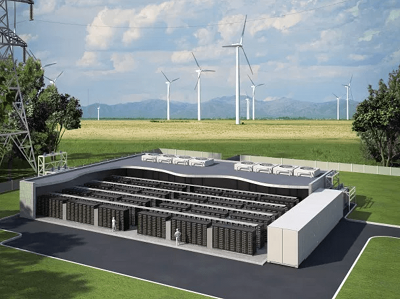In 2022, new energy + energy storage will prosper!
Outbreak
Recently, at the Sixth China Energy Storage Western Forum that it is expected that by the end of this year, China’s new energy storage capacity will exceed 4 million kilowatts.

Lithium-ion-battery storage system
The energy storage industry is in the early stages of its outbreak.
In recent years, thanks to the continuous improvement of technological progress, market demand and related policy mechanisms, the large-scale application of new energy storage(such as lithium battery energy storage BESS) has shown a strong trend.
Energy storage technologies
A variety of energy storage technologies are being widely used in renewable energy development, consumption, integrated smart energy systems, active power distribution networks, and microgrids.
They have obtained achievements in technology and equipment research and development, demonstration project construction, business model exploration, and standard system construction. Substantial progress has been made.
The scale of market-oriented applications such as the participation of new-type energy storage in power auxiliary services, peak shaving and valley filling has steadily expanded, and its supporting role in the energy transition has become increasingly apparent.
In July this year, the “Guiding Opinions on Accelerating the Development of New Energy Storage” issued by the National Development and Reform Commission and the Energy Administration proposed that by 2025, the installed capacity of new energy storage will reach more than 30GW. It can be seen that this is 7.5 times the installed capacity of 4GW at the end of this year. This also means that between 2022 and 2025, there will be at least 26 GW of growth space for new energy storage.
On August 31, the National Energy Administration officially incorporated new energy storage as a market entity and included it in the national grid-connected operation management and auxiliary service management; in September, the National Energy Administration issued the “New Energy Storage Project Management Regulations (Interim Measures)”, Guide industry development.
In addition, the “Notice on Further Improving the Time-of-use Electricity Price Mechanism” and the “Notice on Encouraging Renewable Energy Power Generation Companies to Build or Purchase Peak-shaving Capabilities to Increase the Grid-connected Scale”, etc., further expand energy storage demand and application space.
New energy + energy storage
To vigorously develop photovoltaic and wind power, plus the matured lithium battery technology, as well as potential sodium ion battery, it is necessary to substantially increase the construction of energy storage to make up for the inherent shortcomings of photovoltaic and wind power
As of the end of October 2021, China’s cumulative installed capacity of renewable energy power generation reached 1.02 billion kilowatts, breaking the 1 billion kilowatt mark.
Among them, the installed capacity of hydropower, wind power, solar power and biomass power generation reached 385 million kilowatts, 299 million kilowatts, and 2.82 million kilowatts respectively. 100 million kilowatts and 35.34 million kilowatts, both continue to rank first in the world.
The future installed capacity of wind power and photovoltaics has huge potential in the future:
- First, based on the country’s new installed capacity of 200,000 kilowatts per county, the new increase will reach 134.52 million kilowatts.
- Second, the country is advancing the construction of 100GW large-scale photovoltaic and wind power bases.
- Third, the State Council requires that by 2025, the replacement rate of renewable energy in urban buildings will reach 8%, and the roof photovoltaic coverage rate of new public institutions and new factory buildings will reach 50%.
At the same time, power rationing occurred in many places across the country this year. One of the reasons is due to carbon reduction, and the other is due to insufficient output of wind power and photovoltaic power.
Power outages in many parts of the Northeast have exposed the intermittent and unstable shortcomings of wind power and photovoltaics. Therefore, to vigorously develop photovoltaic and wind power installations, a large amount of energy storage must be configured.
Huge development potential
New energy + energy storage has huge development potential
This year is the year of the outbreak of “new energy + energy storage”. Thanks to the national “dual carbon” strategy and the development of new power systems with new energy as the mainstay, “new energy + energy storage” has become a consensus in the development of the industry , The state and local governments have also issued a number of support policies.
Since the beginning of this year, 21 provinces have issued plans for the development and construction of wind power and photovoltaic power generation, and 14 provinces have also specified their annual scale targets for 2021. According to incomplete statistics, the total installed capacity of “wind power + photovoltaic” power generation is 127.8 GW. If the energy storage capacity is calculated at 10%, it is expected to reach 12.78 GW.
As of the end of 2020, the installed capacity of new energy storage is about 3.3 million kilowatts, ranking first in the world, but there is still a big gap between the 30 million kilowatt development target set by the National Development and Reform Commission and the National Energy Administration. According to this goal, the annual installed capacity of new new energy storage in the next four years will reach more than 5 million kilowatts.
Top-level design
Accelerate the development of new-type energy storage and upgrade it to a “top-level design”, and energy storage will be included in the government’s plan.
17 provinces issued storage allocation requirements and provided subsidies and incentives to promote energy storage development
On October 26, the State Council proposed to optimize the energy consumption structure of new infrastructure, adopt DC power supply, distributed energy storage, and “photovoltaic + energy storage” models to explore diversified energy supply and increase the proportion of non-fossil energy consumption.
According to statistics, up to now, provinces/municipalities have clearly introduced subsidy policies related to photovoltaic energy distribution and energy storage, and 12 provinces have included “photovoltaic + lithium battery energy storage” in the “14th Five-Year Plan”.





